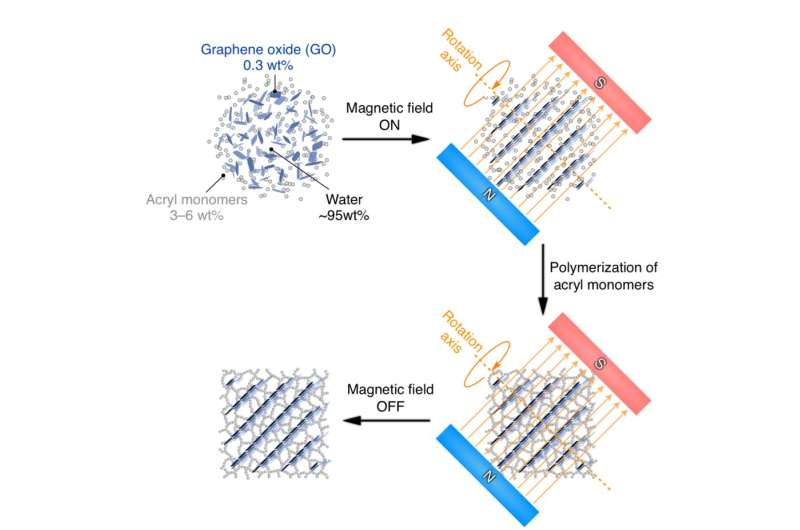
A research group led by scientists from the RIKEN Center for Emergent Matter Science has developed a unique material, based on nanofillers embedded in a hydrogel, that can channel mechanical energy in one direction but not the other, acting in a “nonreciprocal” way.
With this composite material—which can be constructed at various sizes—the team was able to use vibrational up-and-down movements to make liquid droplets rise within a material against gravity. Using this material could thus make it possible to make use of random vibrations and move matter in a preferred direction.
The team’s research paper is published in the journal Science.
Channeling energy in a preferred direction is an important property that actually makes life possible. Many basic biological functions such as photosynthesis and cellular respiration are made possible by channeling random fluctuations in nature in a nonreciprocal way, to drive a system away from increasing entropy, like the famed Maxwell’s demon.
For example, devices that allow energy to move preferentially are in electronics, where they allow AC current to be transformed into DC current. Similar devices are used in the fields of photonics, magnetism, and sound. However, despite the many potential uses, creating devices that channel mechanical energy has proven to be more difficult.
Now, a RIKEN-led group has developed a remarkable but uniform material that is relatively easy to produce and can perform this function. To create it, the group used a hydrogel—a soft material made mainly of water and a polyacrylamide network—and embedded graphene oxide nanofillers into it at a tilted angle. The hydrogel is fixed to the floor, so that the top part can move when subjected to a shear force but not the bottom. The fillers are set at a tilted angle, so that they angle clockwise from top to bottom.
When a shear force is applied from right to left into the leaning nanofillers, they tend to buckle and hence lose their resistance. But if the force is from the other direction, and the nanofillers are facing away from it, the applied shear merely makes them stretch even longer, and they maintain their strength. This allows the sheet to deform in one direction but not the other. The group measured this difference, finding that the material was approximately 60 times as resistant in one direction than the other.
As an experiment to demonstrate what this could actually do, they created a block of the material and placed it on a vibrating stand. Depending on the tilt direction of the embedded nanofillers, the material was able to channel the vibrational energy through the material to make droplets move to the right or left. They could also use the vibrations to drive a circular motion that could be controlled to be either clockwise or anticlockwise. When setting up the vibrating stand vertically, drops of colored liquid that were placed on the hydrogel moved upward against gravity as if by magic. In this way, alternating vibrational movements, which are usually not of any use, were channeled to create net motion.
Finally, as a further test, in collaboration with researchers from the RIKEN Hakubi Fellows program, the group placed Caenorhabditis elegans worms on the material, and although their movements are normally random, they ended up all moving to one side or the another of the hydrogel, depending on the tilt direction of the embedded nanofillers.
According to Yasuhiro Ishida of the RIKEN Center for Emergent Matter Science, who led the project, “It was a remarkable and surprising result, seeing how mechanical energy could be channeled in one direction preferentially, in such a clear way, and using a material that is rather easy to make and quite scalable. In the future, we plan to find applications for this material, with the hope that we can use it to make effective use of vibrational energy, that up until now, has been seen as waste.”
More information:
Xiang Wang et al, Mechanical non-reciprocity in a uniform composite material, Science (2023). DOI: 10.1126/science.adf1206. www.science.org/doi/10.1126/science.adf1206
Bohan Sun et al, A mechanically one-way material, Science (2023). DOI: 10.1126/science.adh3098
Journal information:Science
Provided by
RIKEN

READ MORE
Microplastics come from everywhere—yes, that includes sex toys
Credit: Unsplash/CC0 Public Domain As more research reveals how many microplastic particles humans are ingesting [...]
Nanoparticles: Acidic alert
SEM images of lipid-coated MIL-100(Fe) (e) nanoparticles at 150 000× magnification. Credit: Ploetz et al, [...]
Bedbugs Scurried the Earth Alongside the Dinosaurs 100 Million Years Ago
Bedbugs, which were previously thought to be about 50 million years old, could be much [...]
How are dental partials and bridges different?
How they’re made has a lot to do with their differences. Photodisc/Thinkstock The issue of [...]
Bio-nanocellulose meshes improve hernia repair surgery
Sole Roig, researcher at the NN group at ICMAB-CSIC, showing a sample of a hybrid [...]
Ten Tips From Scientists Who Have Spent Months in Isolation
Danish physician Nadja Albertsen spent a year at Concordia Research Station in Antarctica. ESA/IPEV/PNRA–Nadja Albertsen [...]
To Save Giraffes, We May Need to Put Our Necks Out
Rothschild’s giraffes typically have five nubby horns, or ossicones, instead of the usual two. Melissa [...]
One of the ‘Rarest Butterflies Ever’ May Have Been a Moth All Along
This moth specimen was mistakenly identified as a butterfly in 1793, leaving biologists to wonder [...]